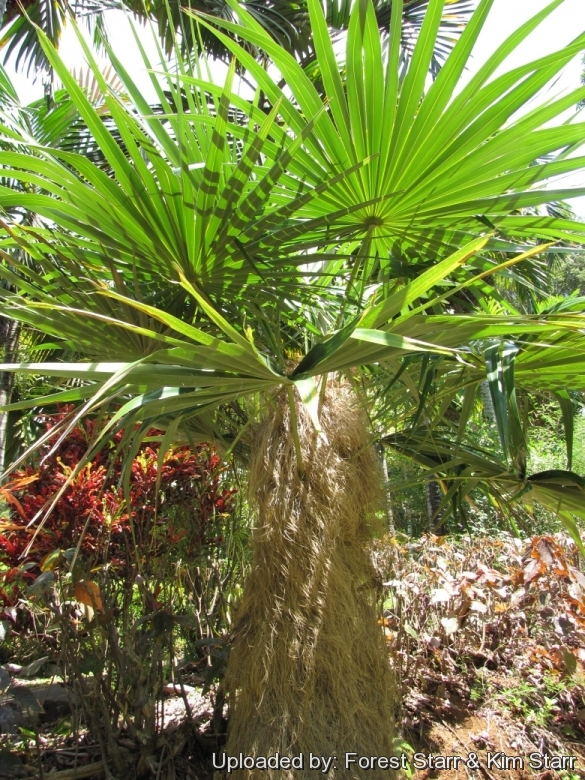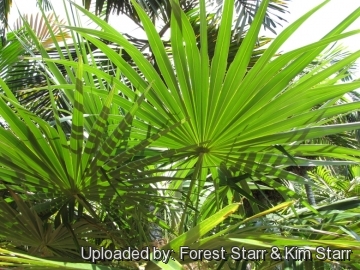Accepted Scientific Name: Coccothrinax crinita (Griseb. & H.Wendl. ex C.H.Wright) Becc.
Webbia 2: 334 (1908)

Thrinax crinita (Coccothrinax crinita) Photo by: Forest Starr & Kim Starr
Habit at Iao Tropical Gardens of Maui, Maui, Hawaii (USA). May 22, 2012.
Origin and Habitat: Tropical Cuba.
Habitat: It usually grows in seasonally flooded savannah, occasionally in hilly areas with unique soil characteristics (serpentine).
Synonyms:
See all synonyms of Coccothrinax crinita
Common Names include:
ENGLISH: Silver palm, Cuban thatch palm, Longsofthair silverpalm, Old Man palm, Thatch palm
CHINESE (中文): Gu ba yin lü
FRENCH (Français): Latanier chevelu, Palma petate (Cuba), Guano petate (Cuba), Guano barbudo (Cuba), Palma petale (Cuba)
Description: Coccothrinax crinitaSN|24889]]SN|24889]] is a very decorative solitary, slow growing palm. Perhaps the most easily recognizable of the group by its light brown trunk hairs (crinita means hairy in Latin). It is called the old man palm because of these long fibres enveloping the trunk and hanging down, making it look a bit like a big “beard”. This “beard” makes this otherwise narrow-stemmed palm look bulky and stout. As a seedling it starts out as an ordinary looking palm but as it starts developing a trunk the new leaves also come out with thatch fibres that are so long that they look like strands of hair.
Stem: 2 to 10 m tall and 8 to 10(-20) centimetres in diameter, completely covered with long hair like fibres with split ends typical of the genus Coccothrinax. It appears bigger because the hair makes a grown tree look fatter than it really is. The thatch fibres are persistent and last for decades.
Leaves: 15 to 25 palmately compound, almost perfectly round, 1,5-1,8 m in diameter and 90 cm long, green above, dull grey below. They are keeled and deeply divided about 38 stiff leaflets, with split tips.
Inflorescence: Flower stalk infrafoliar, 1,5 m long.
Flower: Dioecious, (male and female flowers on separate plants), yellow flowers.
Fruit: Round 0,7 to 2 cm in diameter, wrinkled, purple or black.
Subspecies, varieties, forms and cultivars of plants belonging to the Coccothrinax crinita group
Bibliography: Major references and further lectures
1) Forest & Kim Starr Coccothrinax crinita (Old man palm). Plants of Hawaii. <http://www.starrenvironmental.com>. Downloaded on 21 August 2014.
2) Henderson, Andrew; Gloria Galeano; Rodrigo Bernal. “Field Guide to the Palms of the Americas.” Princeton, New Jersey: Princeton University Press 1995
3) Don Ellison, Anthony Ellison “Cultivated Palms Of The World” UNSW Press, 01/mag/2001
4) Robert Lee Riffle, Paul Craft “An Encyclopedia of Cultivated Palms” Timber Press, Portland 2007
5) John Dransfield, Natalie W. Uhl, Conny B. Asmussen, William J. Baker, Madeline M. Harley, Carl E. Lewis: “Genera Palmarum. The Evolution and Classification of Palms.” Royal Botanic Gardens, Kew 2008
6) Wikipedia contributors. "Coccothrinax crinita." Wikipedia, The Free Encyclopedia. Wikipedia, The Free Encyclopedia, 6 May. 2014. Web. 25 Aug. 2014.
7) Michael J. Balick, Hans T. Beck “Useful Palms of the World: A Synoptic Bibliography” Columbia University Press 1990
8) M.M. Grandtner “Elsevier's Dictionary of Trees: Volume 1: North America” Volume 1 Elsevier, 08/Apr/2005
 Leaves at Iao Tropical Gardens of Maui, Maui, Hawaii (USA). May 22, 2012. (Coccothrinax crinita) Photo by: Forest Starr & Kim Starr
Leaves at Iao Tropical Gardens of Maui, Maui, Hawaii (USA). May 22, 2012. (Coccothrinax crinita) Photo by: Forest Starr & Kim StarrSend a photo of this plant.The gallery now contains thousands of pictures, however it is possible to do even more. We are, of course, seeking photos of species not yet shown in the gallery but not only that, we are also looking for better pictures than those already present.
Read More... Cultivation and Propagation: Coccothrinax crinitaSN|24889]]SN|24889]] is an undemanding and easy palm for smaller gardens and adapt to a wide range of conditions in the tropics and subtropics. It is painfully slow growing, especially as a seedling, but once established will grow moderately fast, so for this reason a tree with a bit of trunk can cost the same as a second hand car.. As with most of the Cuban palms, this species is accustomed to hot humid summers, and dry warm winters. It is always one of the most admired palms. Highly recommended.
Soil requirements: It is not particular for the soil, provided perfectly draining and fertile even if it prefers the alkaline or neutral ones. However it is widely adaptable and can even thrives in poor soils, but do better when grown in nutrient-rich soils with regular watering. Avoid those soils that are soggy.
Watering: It may resist to long drought periods, but it profits of regular watering especially in the warmest periods. Don't let sit in water.
Light: It adapts well to full sun or half sun, but seems to prefer some shade until trunking.
Fertilization: Need a perfect fertilizer diet including all micro nutrients and trace elements. It is subject to potassium deficiency.
Aerosol salt tolerance: It is very tolerant to salt spray all over it and even salt water, but does a better inland then it does on the coast.
Hardiness: This is a great palm for tropical areas of the world, (USDA Zones 10-12). Minimum Tolerated Temperature is about -3 °C, or little less, just for a very short time. It may also performns well in some temperate micro-climate but growth is much slower.
Wind hardiness: It can tolerate sweltering heat and moderately windy conditions.
Ornamental use: It is the most imposing of all the Copernicia, of particular ornamental and landscape value due to the robust whitish cylindrical stems and the thick top with the rigid leaves; ideal for lining wide avenues, or utilized as isolated specimen or in group, in parks and very wide gardens in the tropical and subtropical climate zones.
Traditional uses: The large leaves of this palm are traditionally used for thatch.
Disease & Pests: It is quite resistant to pests but may require regular fertilization to prevent yellowing caused by potassium deficiencies; protect against frost.
Propagation: It reproduces by seed which germinates in 2-3 months; the growth initially is rather slow. The seeds germinate very easily when fresh. If not properly treated, the seed does not have long shelf life.










